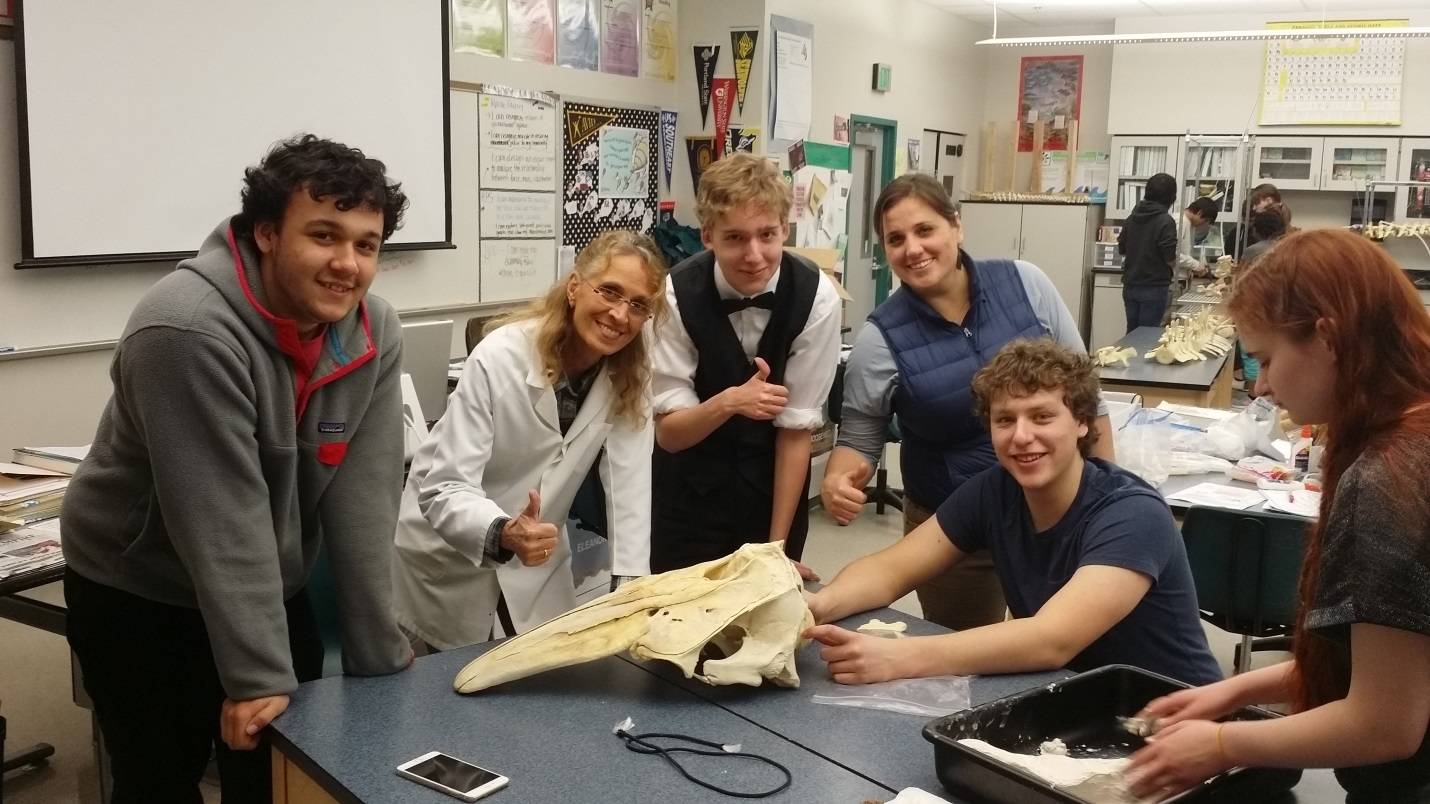On many days what may seem like chaos to the casual observer is actually the active engagement and empowerment of 32 young minds in our DEM BONES class. These students are often insecure in their ideas. They get nervous and ask, “Did I do this right?” More often than not, our response is, “Show me your thinking.” The true beauty of the DEM BONES project is that it provides young minds with the opportunity first to struggle and then, at some point, “glue it together” for success!
The scene just described happens in most every lab session of the class affectionately known as DEM BONES, the acronym for Distinctive Education in Motion: Biodiversity Of Nature and Environmental Stewardship. In this class, students articulate the skeleton of a marine mammal and learn about topics as diverse as anatomy, ecology, marine policy, and cultural uses of marine mammals. Officially, the class is a dual high school and University of Alaska credit class, called FISH 100. One of the long-term goals of FISH 100 is to encourage young people to pursue higher education and stay in science, technology, engineering, and/or math. The class has been offered for eight years at Thunder Mountain High School and once in Sitka. Alternate versions of the class have also been offered at Yaakoosgé Daakahídi and through the Sitka Sound Science Center.
The course depends on an irregular and uncertain supply of marine mammal carcasses which have succumbed for a wide variety of reasons. This last semester we faced the sad and difficult task of working with a neonatal killer whale that had been born too early. Though its untimely death was unfortunate, it did inspire a great learning experience. Three high school students, four UAS undergraduates, five UAF graduate students, one marine biology teacher, the TMHS principal, and two UAF professors ventured out to learn from the whale remains on a rainy November morning. For most of the people involved, the authentic task of performing a beach necropsy and harvesting the skeleton was a life changing opportunity.
Articulating this amazing animal became our biggest challenge to date. The skull crumbled to pieces, translating into a headless display. Luckily, our team loved a good challenge. When we came up with the idea to 3D print a new skull, the students embraced the task. As happens so frequently with adults and new technology, we looked to our youth to teach us. With the assistance of one of the most talented gamers in the class, a student taught himself how to take a printable 3 dimensional .stl file and slice and enlarge it. He took a 4-inch model and built one that fit our whale. This is but one of the tales to be told of the DEM BONES class.
The paths of our DEM BONES students are varied, but we believe their hands-on experiences in the class provide direction for many. One student ended up at a Stanford University with a major in zooarchaelogy. She and and her mother credit DEM BONES with pointing her in that direction. We’ve been able to proudly watch as other alumni cross the stage at UAS graduation. Wherever they end up, these students seem to be finding success.
Collaborating on this project has been great in all the ways a learning experience should be. We have been inspired by our students just as we hope we have inspired them.
STEM Corner Activity
The DEM BONES students had to figure out what underlying skull structure makes the shape of the whale head — and then how to create that skull out of plastic.
Here is an activity that gets kids (and adults) thinking about the ideas of structure and function, by analyzing what’s going on inside human bodies — under our skin — to give us our shape and make us move.
The link provides videos, questions, and resources so that it can be accessed from home or from a classroom setting. There are lots of great video clips and stills of robots, X-rays, and chicken dissections. There’s also a template and instructions for building a simple, but moving robot finger out of paper and string.
The Muscles and Mystery Science link is at https://tinyurl.com/y9ugc6r3.
• Kristen Wells is a Thunder Mountain High School Teacher. Shannon Atkinson is a UAF Professor for the College of Fisheries and Ocean Sciences. They are co-instructors for DEM BONES. STEM Corner is a monthly column about Science Technology Engineering and Math in Juneau, written by a rotating group of Juneau STEM Coalition members.

